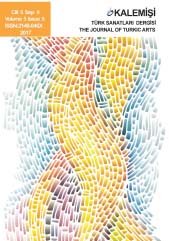Türk-İslam Sanatları Tarihinde Bazı Yanlış Varsayımlar
SOME FALSE AFFILIATES ON TURKISH-ISLAMIC ARTS HISTORY
Author(s): Lale AvşarSubject(s): History, Fine Arts / Performing Arts, Visual Arts, Islam studies, Culture and social structure
Published by: Sanat ve Dil Araştırmaları Enstitüsü
Keywords: Islamic ceramic art; Turkish art effects; False assumptions;
Summary/Abstract: Early Islamic Ceramic Art and especially Pre-Seljuk period are not generally taken into account in terms of the Turkish art effects. This is based on traditional assumption of established in the history of art. According to this, the Islamic ceramic art has developed and emerged from sources of Sasani Iran and Christian Byzantine, in time, cultural and commercial relations have resulted in the emergence of new sources due to aspire of Chinese ceramic art and especially the Chinese porcelain. Reviews about Samarra ceramics of Abbasi period has revealed effects of Turkish art. These effects, firstly encountered in white opaque glazed and lustre ceramics. Also, it present in compositional arrangement, in human and alive representations, in clothes, in sitting style, in hand-held object and in some other details. The question of why such influences are so unrecognized up to now brings to mind the existence of some conceptual problems by philosophical direction of the research. In the research, this issue has been tried to be define of the thoughts that we believed to be misplaced. The aim, monitor of their accuracy and re-evaluations by coming to the fore to certain assumption.
Journal: Kalemişi - Türk Sanatları Dergisi
- Issue Year: 5/2017
- Issue No: 9
- Page Range: 45-59
- Page Count: 15
- Language: Turkish

